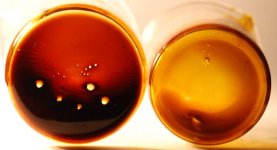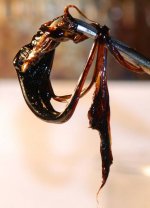dope_roor
Member
I'm trying to figure out exactly how decarboxylation and isomerization of THC occurs and what methods can be employed to do so.
I have some some background organic chemistry knowledge and understand that decarboxylation of marijuana is the conversion of THCA into THC, THCA being psychoinactive whereas THC is. On a molecular level, it's the removal of a COOH group from the THC molecule, which can be done under conditions of high heat or presence of a strong base.
I've read that perhaps the process of curing buds is actually a slow decarboxylation process and thus the increasing of potency we generally observe.
Based on this, it's reasonable to assume that applying heat increases the potency of marijuana. And there's evidence of this in making cannabutter from schwag or whipping up BHO over heat or the heat pressing of kief into hash. some sort of increase in potency from the original product.
Is it not then also plausible that washing or soaking the bud in an alkaline (basic pH >7) should also cause decarboxylation? Perhaps a more thorough decarboxylation than whipping over heat? And, as long as the solution is polar, the THC should not be affected?
The implications of this are perhaps washing our buds in an alkaline solution before performing our preferred method of extraction could increase the end potency of the extract?
Onto isomerization, I understand that it is the rearrangement of the molecule structure. What causes THC to isomerize? I believe the cannabis alchemy articles and other info from the 70's use a strong acid to cause the isomerization. First of, is there any truth in this?Can other methods cause such isomerization?
Just trying to clear things up, it seems that some people confuse the two, and I'm thinking that these are two distinct processes that can occur/be performed to increase potency
I have some some background organic chemistry knowledge and understand that decarboxylation of marijuana is the conversion of THCA into THC, THCA being psychoinactive whereas THC is. On a molecular level, it's the removal of a COOH group from the THC molecule, which can be done under conditions of high heat or presence of a strong base.
I've read that perhaps the process of curing buds is actually a slow decarboxylation process and thus the increasing of potency we generally observe.
Based on this, it's reasonable to assume that applying heat increases the potency of marijuana. And there's evidence of this in making cannabutter from schwag or whipping up BHO over heat or the heat pressing of kief into hash. some sort of increase in potency from the original product.
Is it not then also plausible that washing or soaking the bud in an alkaline (basic pH >7) should also cause decarboxylation? Perhaps a more thorough decarboxylation than whipping over heat? And, as long as the solution is polar, the THC should not be affected?
The implications of this are perhaps washing our buds in an alkaline solution before performing our preferred method of extraction could increase the end potency of the extract?
Onto isomerization, I understand that it is the rearrangement of the molecule structure. What causes THC to isomerize? I believe the cannabis alchemy articles and other info from the 70's use a strong acid to cause the isomerization. First of, is there any truth in this?Can other methods cause such isomerization?
Just trying to clear things up, it seems that some people confuse the two, and I'm thinking that these are two distinct processes that can occur/be performed to increase potency






 :
:
